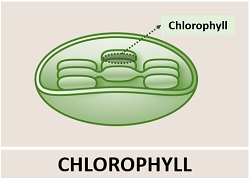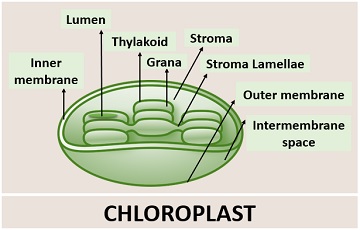The difference between chlorophyll and chloroplast is due to the following factors like location and involvement in photosynthesis.
Existence: Chlorophylls exist as the primary photosynthetic pigments inside the chloroplast. Conversely, chloroplasts exist as the photosynthetic cell organelles in a plant cell and possess a membranous structure that resembles mitochondria.
Involvement in photosynthesis: Chlorophyll mainly absorbs blue and red light energy from the sun and converts it into chemical energy, whereas chloroplast serves as a site where photosynthesis occurs.
To get the idea of chlorophyll and chloroplast involvement in the photosynthetic activity of a plant system, let us suppose:
- Chloroplast acts as a unit where food is produced and stored.
- Chlorophyll acts as the workers which prepare products by the assistance of sunlight.
- Consider sunlight as a fuel that provides a natural energy source to the chlorophyll for food production.
- And, carbon dioxide and water serve the raw materials in food preparation.
Content: Chlorophyll Vs Chloroplast
Comparison Chart
| Properties | Chlorophyll | Chloroplast |
|---|---|---|
| Definition | Chlorophyll refers to the green photosynthetic pigment that participates in the photosynthetic activity of the plants | Chloroplast refers to the green membranous structure that provides the site for the photosynthetic activity |
| DNA | It lacks DNA | Chloroplast contains its own DNA (cp-DNA) |
| Location | It is located within the stacks-like thylakoid of the chloroplast | It is located within mesophyll cells of the leaves |
| Types | Basically of five types, but chlorophyll-a and b are the two major groups | Chloroplast is a type of plastid and not classified into any groups |
| Functional role | It performs a functional role in conversion of absorbed light energy to chemical energy by preparing organic food for a plant | It performs a functional role in providing space and enzymes during the light and dark reaction of photosynthesis |
| Imparts colour | It imparts an intense green colour to the chloroplasts | It is responsible for the green colouration of the leaves |
| Occurrence | It is ubiquitous in plants, cyanobacteria and algae | It is ubiquitous in plants and algae |
| Structure | Its structure consists of central magnesium atom, tetrapyrrole ring and a side phytol chain | Its structure consists of outer membrane, intercellular space, outer membrane and specialized thylakoid membrane |
| Identifying feature | It is a plant pigment | It is a cell organelle |
Definition of Chlorophyll
Chlorophyll refers to the primary pigment produced by the plants, which directs photosynthesis to prepare food. It functions by absorbing the light energy (sunlight) and storing the chemical energy (ATP and NADH) to perform cellular functions. Plants use chlorophyll pigments to convert the absorbed light energy and carbon dioxide into chemical energy as organic food (carbohydrate). Its occurrence is ubiquitous in all photosynthetic organisms like higher plants, protists etc.

The location of chlorophyll is within the stack-like thylakoids. Generally, there are five kinds of chlorophyll, namely chl-a, chl-b, chl-c, chl-d and chl-f. Among all the types, chl-a and chl-b are the major groups that primarily take part in both light and dark reactions of the plant. The chemical structure of chlorophyll consists of the following elements:
- Central magnesium atom
- Porphyrin ring
- Phytol side chain
The different groups of chlorophyll vary in their chemical composition in having similar central atom and porphyrin ring but different side chain. Chlorophyll is a fat-soluble organic molecule. Its chemical structure is more or less identical to the chemical structure of haemoglobin (oxygen-carrying pigment). Chlorophylls are also considered magnesium chlorins or tetrapyrrole pigments or chlorin pigments as they have tetrapyrrole ring.
Functions: Chlorophyll performs the following tasks:
- It imparts green colour to the plants by absorbing light radiations.
- Besides photosynthesis, chlorophyll also protects plants against oxidative stress and UV damage.
Definition of Chloroplast
Chloroplasts refer to the membranous structures located within the mesophyll cells and concentrated by the parenchymatous cells in the leaves. Chloroplast occurs as a site of photosynthetic activity by the plants. Its structure looks similar to the mitochondrial membrane by having:

Outer smooth layer: It imports the nuclear-encoded proteins, and acts as a site for the biosynthesis of lipids and provides a physical barrier for the movement of molecules or ions.
Inner smooth membrane: It helps in synthesizing different metabolites and the cell division of cell organelles.
Intermembrane space: It represents the middle space between the chloroplast’s smooth outer and inner layer, whose diameter is about 10-20 nm.
Besides, chloroplast contains an internal thylakoid membrane. It possesses several specialized stack-like structures called “grana” surrounded by aqueous stroma and connected by stroma lamellae.
Functions: Chloroplast performs the following tasks:
- It is solely involved in the photosynthesis process of plants.
- Chloroplast generates metabolic energy for the plant.
- It also functions in the storage of food.
Key Differences Between Chlorophyll and Chloroplast
- Chlorophyll is a chlorin pigment that traps the red and blue light of the electromagnetic spectrum and transmits green light during photosynthesis. A chloroplast is a cell organelle that acts as a site for all the photosynthetic activity by providing space and enzymes.
- Chlorophyll is devoid of its DNA, whereas chloroplast contains its own DNA (cp-DNA) like mitochondria.
- Chloroplasts exist as small reticulations within the mesophyll cells of a leaf, while chlorophylls are the plant pigments located within the thylakoids discs.
- Chlorophyll-a, b, c, d and f are the five groups, among which chlorophyll-a and b are the two major groups that predominate in a plant. The chloroplasts are the most common type of plastid characterized by two membranous structure with high chlorophyll content.
- Chlorophylls impart an intense green colour to the chloroplasts by absorbing a light wavelength (usually red and blue) of the visible light spectrum and reflecting green.
Chloroplast appears green because of the chlorophyll presence within the infolded thylakoids, which imparts green colour to the leaves. - The structure of chlorophyll comprises a central magnesium atom, tetrapyrrole ring and a varying side chain, due to which it is also termed as “Magnesium tetrapyrrole pigments”.
Chloroplast structure mainly comprises two membranes (outer and inner), specialized thylakoid membrane and intercellular space within the outer and inner layer.
Similarities
- Both are involved in the photosynthetic activity of a plant.
- Chlorophylls and chloroplasts are present in higher plants and algae.
- Both appear green-coloured.
Conclusion
Therefore, we can conclude that both the chlorophyll and chloroplasts are essential for many reasons, like:
- The green colour of the leaf.
- Splitting of water and CO2 into glucose and oxygen or in the photosynthetic activity by a plant.
Both play their unique role in a plant cell and works together by helping plant in many ways.